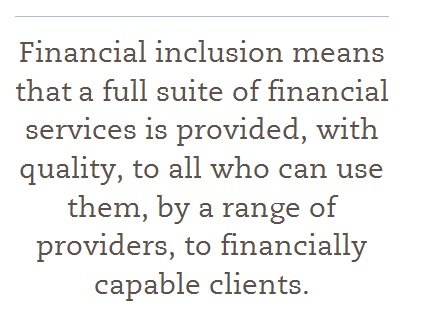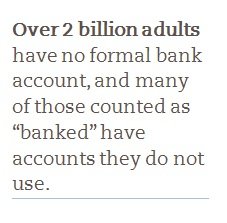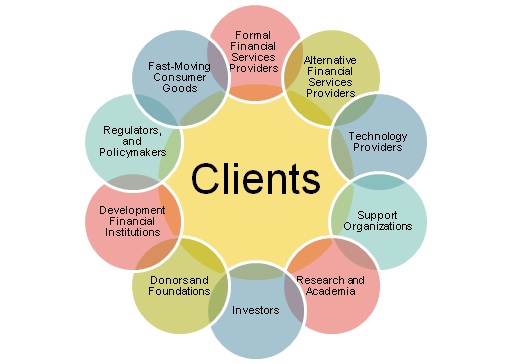Meeting Client Needs with Access and Quality by 2020
 Financial Inclusion 2020 (FI2020) is building a movement that mobilizes stakeholders around the globe to achieve full financial inclusion, using the year 2020 as a focal point for action.
Financial Inclusion 2020 (FI2020) is building a movement that mobilizes stakeholders around the globe to achieve full financial inclusion, using the year 2020 as a focal point for action.
Low and moderate income people around the world need financial services such as credit, savings, insurance, and payments to assist them in managing their lives and to build better futures for their families. However, very few have access to such services from formal financial service providers. Moreover, our concept of full inclusion goes beyond access to include a focus on the quality of services and the capability of clients to use them. Quality financial inclusion goes hand in hand with building a stable financial system, deepening the financial sector, and promoting broad economic participation and growth.
Financial inclusion is increasingly seen as a priority policy goal, but a coherent “movement” in that direction remains elusive for a number of reasons: the diverse range of actors who need to be involved, understanding the financial needs of the underserved, and the changing opportunities technology presents, to name only a few.
Financial Inclusion 2020 is building a shared roadmap for action, working in partnership with other organizations with specialized expertise. The Center for Financial Inclusion has a track record of promoting dialogue among decisionmakers and developing a shared language and vision, with an eye toward turning vision into action. FI2020 builds on existing resources and industry efforts for financial inclusion, and incorporates geographic diversity and the perspectives of a range of stakeholders.
The Stage Is Set for Dramatic Leaps in Inclusion
Over the next decade, technology advances and economic growth in developing countries will enable many who have been excluded from access to financial services to become valued clients. Technology will make services more available and affordable, while income growth will fuel a demand in services. Access to financial services is accelerating for other reasons, as well:
 Microinsurance is burgeoning. The International Labor Organization reports that microinsurance is now reaching half a billion people. The potential market for microinsurance, according to Lloyds, is between 1.5 billion and 3 billion policies.
Microinsurance is burgeoning. The International Labor Organization reports that microinsurance is now reaching half a billion people. The potential market for microinsurance, according to Lloyds, is between 1.5 billion and 3 billion policies.
Big private sector players are making plays in the market. Fast moving consumer goods companies can leverage their experience with supply and demand chains to reach low income producers, distributors and consumers.
High level policymakers across the global community are promoting financial inclusion. The G20 has named financial inclusion among its priorities and is following through with actions such as promoting the incorporation of financial inclusion perspective into standard setting bodies like the Basel Committee on Banking Supervision (BCBS) and Financial Action Task Force (FATF). Furthermore, central bankers and ministers of finance from over 80 nations in the Global South are participating in the Alliance for Financial Inclusion (AFI)—a global network of financial policymakers working to advance inclusion.
Data is increasingly available. For example, the new Global Findex provides, for the first time comparable, demand-side data on financial service use across more than 100 countries. And “big data” is revolutionizing credit reporting by capturing information from alternative sources such as phone logs and utility bills, which provides new opportunities to create credit histories for millions of people.
The importance of a client focus is gaining momentum. Initiatives such as the Smart Campaign, Microfinance Transparency, the Social Performance Taskforce, and the Paris Appeal, are looking at how financial consumers can be protected and benefit from engagement with formal financial services. Industry researchers and innovators, such as Grameen’s AppLab, IFMR Trust, and Nokia, are working to create new services and delivery methods that better address client needs.
Engaging Diverse Players to Achieve a Unified Goal
Full financial inclusion will only be possible with collaboration among the private, public, and non-profit sectors. FI2020 is bringing together a diverse group of stakeholders to identify the most important steps each can take to advance financial inclusion around the globe. All of these unique stakeholders’ interests can align for a larger purpose:

Through FI2020, we aim to achieve:
- Clearer agreement among major players about the path to full inclusion
- Greater unity among policy makers and financial services providers
- Creation of new relationships to promote cooperation in a neutral setting
- Better understanding of the role of microfinance in financial inclusion
- Growth of political will to achieve financial inclusion by 2020
- Greater emphasis in financial inclusion on quality and the hard-to serve
Learn more about FI2020:
Roadmap to Inclusion
Focused on five areas to achieve full financial inclusion -- Addressing Customer Needs, Financial Capbility, Credit Reporting and Data, Technology, and Client Protection -- each FI2020 Roadmap asks: What is the vision for this topic? What stands in the way of achieving the vision and where are the greatest opportunities? What are the enabling actions and corresponding actors who can advance the vision? Read the Roadmaps.
- Also available: The FI2020 Progress Report, presenting FI2020's assessment of progress toward global financial inclusion through the lens of the five Roadmap topics: The report provides a qualitative and interactive assessment of who is doing what, celebrating the most significant accomplishments, and highlighting the gaps that constitute the agenda for the coming years. We invite you to use the interactive feature on the website to cast your own vote and compare your scores to ours.
Mapping the Invisible Market
The Mapping the Invisible Market project provides data, analysis, and tools to examine how major forces such as demographic change, income growth, and technology will influence the evolution of financial inclusion over the next decade. In doing so, it contributes a fact base to FI2020’s efforts to create a movement toward full financial inclusion by the year 2020.
- Inclusion Visualizer: Designed by CFI and and powered by MIX, the visualizer is a tool intended to manipulate, visualize, and download images of data related to financial inclusion. Users can create their own charts with the ability to control variables and segment down to the country-level, or to organize data by region and income level.
- By the Numbers: A quantitative review of the current status of financial inclusion globally, relying on the two Findex datasets supplemented by data from the EIU Global Microscope 2014, UN, World Development Indicators, IMF, Alliance for Financial Inclusion, and the GSMA State of the Industry.
- Aging and FInancial Inclusion: An Opportunity: A joint publication with HelpAge International report on aging and financial services with action recommendations.
- Growing Income, Growing Inclusion proposes that massive income growth around the world over this decade will have a significant effect on the demand for and use of formal financial services.
- Looking Through the Demographic Window shows how profound demographic shifts in the developing world have important implications for financial inclusion.
FI2020 Week (November 2-6, 2015)
FI2020 Week served as a launching point for conversations across the globe that focus on quality (the value to customers) and outreach (reaching more people, especially those most excluded) as the double hearts of financial inclusion. Learn more and read calls to action from events and stakeholders worldwide on the FI2020 Week website. Also see: the FI2020 Week Roundup E-Magazine that sums up the week with a focus on event highlights, social media activity, and calls to action.
FI2020 News Feed
Each week the FI2020 team at CFI highlights compelling stories and content on all things financial inclusion from across the web. Click here to visit the news feed.
Other FI2020 Publications
- FI2020 E-Zine: Three Essential Debates. Will microfinance continue to be relevant in 2020 and beyond? Should regulators or the industry lead on client protection? Will data analytics replace traditional credit reporting systems? A new Financial inclusion 2020 e-magazine explores these three essential questions debate-style.
- FI2020 E-Zine: 2014 Round-Up. One year after the Global Forum, CFI reviewed how the drive for financial inclusion is faring – new ventures, milestones, and ongoing debates.
- Global Microscope 2014. The 2014 Microscope examines the inclusiveness of countries' financial sectors by considering best practices in the national regulatory environment and institutional support in the safe provision of a wider range of financial products and services to low income populations.
- Seizing the Moment: On the Road to Financial Inclusion. In this report, we look at why financial inclusion matters and why we are confident it can be achieved in the foreseeable future.
- Opportunities and Obstacles to Financial Inclusion in Peru. Oikocredit Perú and CFI joined forces to carry out a country-specific version of this study in Peru in 2012-2013. Peru was chosen in recognition of developments in the microfinance market, market regulation and rules, the free competition model and the present government's interest in working towards financial, economic and social inclusion.
- Opportunites and Obstacles to Financial Inclusion. This paper presents and analyzes the results of a survey conducted on industry participants from around the world. The report uses the survey findings to create a ranking, in order of significance, of opportunities and obstacles in financial inclusion.
FI2020 Global Forum
The Global Forum was a landmark event for expanding global financial inclusion. With an innovative approach and carefully selected participants, the Global Forum engaged a broad range of players in financial inclusion in a collaborative environment where they mapped the action agenda for achieving financial inclusion by the year 2020. Taking place in London, October 28-30, 2013, the Forum communicated the findings of the FI2020 Roadmap to Financial Inclusion and Mapping the Invisible Market to the key players capable of making full financial inclusion a global reality. Learn more and watch the sessions and panel discussions.




